An Improved Method for Predicting the Greenfield Stratum Movements Caused by Shield Tunnel Construction
Abstract
:1. Introduction
2. Basic Theory and Calculation Method
2.1. Disturbance Factors
2.2. Gap Parameter
2.3. Loganathan’ Solution
2.4. Sagaseta’s Solution
2.5. An Improved Method
3. Compared with Centrifugal Test Results
3.1. Material Properties
3.2. Comparative Analysis of Results
4. Conclusions
- (1)
- A new method for predicting the stratum movements caused by EPB shield tunnel construction is developed that combines an elastic half-space model of mirror source–sink method with the use of modified analytical method. Compared with the effect of a physical gap, the stratum movements caused by the additional force on the shield working face and the frictional force between the outer surface of the shield and the surrounding soil during tunnel construction is very small. Therefore, this paper neglects the effects of the latter two factors when analyzing, and mainly studies the effects of the physical gap. The method also takes into account non-equivalent radial ground loss.
- (2)
- Sagaseta’s method assuming equivalent radial movement pattern can only obtain the surface movements from the tunnel excavation. Considering non-equivalent radial displacement model, Loganathan’s solution modifies Verruijit’s analytical formula by exponential function, but it is only applicable to plane strain cases. The two methods have great limitations. For example, they cannot show the soil displacement of the x = y plane. If there is a new shield tunnel skewed with an old tunnel or pipeline and the displacement effect at the old tunnel or pipeline needs to be calculated, neither of the above two methods will apply. This paper combines the advantages of the two methods to derive a formula for predicting the three-dimensional stratum displacement caused by shield tunneling.
- (3)
- Vertical displacement contours in the central part show good consistency and regularity, with a larger difference at the edge. Centrifugal contours are nearly straight-line contours, while the improved solution contours are arc. Vertical displacement has a relatively small numerical value and its regularity is not obvious. The shape and distribution position of centrifugal contours and improved contours are similar. The difference also shows an increasing trend from the center to the edge, and the improved solution contours shift to the right a little and has a wider range. One of the important reasons is that sand soil is chosen in the centrifugal test but part of Loganathan’s solution is fitted with clay data and is only applicable to clay soil. The current centrifugal tests are mostly based on sand. However, suitable clay centrifugal tests are hard to find. Considering the inevitable errors in the centrifugal test and theoretical calculations, the comparison results are acceptable. The values of Loganathan’s contours are larger than the other two, because Loganathan’s solution is the plane strain method; namely, it is a final stratum displacement from the excavation of an infinite tunnel. However, in the test and the improved method, the tunnel length is finite, the distance between the measuring plane and the tunnel face is much shorter, so their displacements are smaller than the final displacement.
Author Contributions
Funding
Acknowledgments
Conflicts of Interest
References
- Zhang, H.; Chen, L.; Zhu, Y.; Zhou, Z.; Chen, S. Stress Field Distribution and Deformation Law of Large Deformation Tunnel Excavation in Soft Rock Mass. Appl. Sci. 2019, 9, 865. [Google Scholar] [CrossRef]
- Zhang, Z.Q.; Zhang, H.; Tan, Y.J.; Yang, H.Y. Natural wind utilization in the vertical shaft of a super—Long highway tunnel and its energy saving effect. Build. Environ. 2018, 145, 140–152. [Google Scholar] [CrossRef]
- Zhu, Y.; Chen, L.; Zhang, H.; Zhou, Z.; Chen, S. Physical and Mechanical Characteristics of Soft Rock Tunnel and the Effect of Excavation on Supporting Structure. Appl. Sci. 2019, 9, 1517. [Google Scholar] [CrossRef]
- Zhang, H.; Chen, L.; Chen, S.G.; Sun, J.C.; Yang, J.S. The spatiotemporal distribution law of microseismic events and rockburst characteristics of the deeply buried tunnel group. Energies 2018, 11, 3257. [Google Scholar] [CrossRef]
- Tang, F.; Li, L.J.; Dong, M.S.; Wang, Q.; Mei, F.Z.; Hu, L.H. Characterization of buoyant flow stratification behaviors by Richardson (Froude) number in a tunnel fire with complex combination of longitudinal ventilation and ceiling extraction. Appl. Therm. Eng. 2017, 110, 1021–1028. [Google Scholar] [CrossRef]
- Mei, F.Z.; Tang, F.; Ling, X.; Yu, J.S. Evolution characteristics of fire smoke layer thickness in a mechanical ventilation tunnel with multiple point extraction. Appl. Therm. Eng. 2017, 111, 248–256. [Google Scholar] [CrossRef]
- Sun, J.; Zhang, H.; Huang, M.; Chen, Q.; Chen, S. Reasonable Paths of Construction Ventilation for Large—Scale Underground Cavern Groups in Winter and Summer. Sustainability 2018, 10, 3768. [Google Scholar] [CrossRef]
- Lin, F.; Chen, S.G.; Zhang, H. Study on type selection of shield equipment in different geological conditions. In Green Building, Materials and Civil Engineering; CRC Press: Boca Raton, FL, USA, 2014; pp. 391–394. [Google Scholar]
- Zhang, H.; Chen, S.G.; Deng, X.F. Analysis on Influence of Shield Tunneling on Ground and Bridge Pile. Chin. J. Undergr. Space Eng. 2011, 7, 552–557. [Google Scholar]
- Zhang, H.; Chen, S.G.; Tan, X.R. Research on the Mechanical Behavior of a Segment of a Shield Tunnel Adjacent to a Pile Foundation. Mod. Tunn. Technol. 2012, 49, 101–107. [Google Scholar]
- Zhou, Z.L.; Chen, S.G.; Li, Y.S. Research on Predicting and Distribution of Stratum Displacement of Double—Tube Parallel Shield Tunnel. J. Highw. Transp. Res. Dev. 2015, 32, 109–117. [Google Scholar]
- Zhang, H.; Chen, S.G.; Deng, X.F. Analysis of the Influence of Shield Driving Parameters on Ground Settlements. Mod. Tunn. Technol. 2010, 47, 48–53. [Google Scholar]
- Lu, D.C.; Kong, F.C.; Du, X.L.; Shen, C.P.; Gong, Q.M.; Li, P.F. A unified displacement function to analytically predict ground deformation of shallow tunnel. Tunn. Undergr. Space Technol. 2019, 88, 129–143. [Google Scholar] [CrossRef]
- Franza, A.; Marshall, A.M. Empirical and semi—Analytical methods for evaluating tunneling—Induced ground movements in sands. Tunn. Undergr. Space Technol. 2019, 88, 47–62. [Google Scholar] [CrossRef]
- Losacco, N.; Viggiani, G. Class A prediction of mechanised tunnelling in Rome. Tunn. Undergr. Space Technol. 2019, 87, 160–173. [Google Scholar] [CrossRef]
- Do, N.A.; Dias, D.; Oreste, P.; Djeran, I. Three—Dimensional numerical simulation of a mechanized twin tunnels in soft ground. Tunn. Undergr. Space Technol. 2014, 42, 40–51. [Google Scholar] [CrossRef]
- Chen, R.P.; Zhu, J.; Liu, W.; Tang, X.W. Ground movement induced by parallel EPB tunnels in silty soils. Tunn. Undergr. Space Technol. 2011, 26, 163–171. [Google Scholar] [CrossRef]
- Xie, X.Y.; Yang, Y.B.; Ji, M. Analysis of ground surface settlement induced by the construction of a large—Diameter shield—Driven tunnel in Shanghai, China. Tunn. Undergr. Space Technol. 2016, 51, 120–132. [Google Scholar] [CrossRef]
- Peck, R.B. Deep excavations and tunneling in soft ground. State of the Art Report. In Proceedings of the 7th International Conference on Soil Mechanics and Foundation Engineering, Mexico City, Mexico, 5 August 1969; pp. 225–290. [Google Scholar]
- Attewell, P.B. Ground Movements Caused by Tunneling in Soil. Large Ground Movements and Structures; Pentech Press: London, UK, 1978; pp. 812–948. [Google Scholar]
- New, B.M.; O’Reilly, M.P. Tunnelling induced ground movements: Predicting their magnitude and effects. In 4th Int. Conf. Ground Movements and Structures; Pentech Press: Cardiff, Wales, 1991; pp. 671–697. [Google Scholar]
- Mair, R.J.; Gunn, M.J.; O’Reilly, M.P. Ground movement around shallow tunnels in soft clay. Tunn. Tunn. Int. 1982, 14, 45–48. [Google Scholar]
- Mair, R.J.; Taylor, R.N.; Bracegirdle, A. Subsurface settlement profiles above tunnels in clays. Geotechnique 1993, 43, 315–320. [Google Scholar] [CrossRef]
- Meguid, M.A.; Saada, O.; Nunes, M.A.; Mattar, J. Physical modeling of tunnels in soft ground: a review. Tunn. Undergr. Space Technol. 2008, 23, 185–198. [Google Scholar] [CrossRef]
- Klar, A.; Vorster, T.E.B.; Soga, K.; Mair, R.J. Soil—Pipe interaction due to tunnelling: Comparison between Winkler and elastic continuum solutions. Geotechnique 2005, 55, 461–466. [Google Scholar] [CrossRef]
- Celestino, T.B.; Gomes, R.A.M.; Bortolucci, A.A. Errors in group distortions due to settlement trough adjustment. Tunn. Undergr. Space Technol. 2000, 15, 97–100. [Google Scholar] [CrossRef]
- Vorster, T.E.B.; Klar, A.; Soga, K.; Mair, R.J. Estimating the effects of tunneling on existing pipelines. J. Geotech. Geoenviron. Eng. 2005, 131, 1399–1410. [Google Scholar] [CrossRef]
- O’Reilly, M.P.; New, B.M. Settlement above tunnels in the United Kingdom their magnitude and prediction. In Proceedings of the Tunneling’ 82 Symposium, London, UK, 7–11 June 1982; pp. 173–181. [Google Scholar]
- Osman, A.S.; Bolton, M.D.; Mair, R.J. Predicting 2D ground movement around tunnels in undrained clay. Geotechnique 2006, 56, 597–604. [Google Scholar] [CrossRef]
- Pinto, F.; Whittle, A.J. Ground Movements due to Shallow Tunnels in Soft Ground. I: Analytical solutions. J. Geotech. Geoenviron. Eng. 2013, 140, 04013040. [Google Scholar] [CrossRef]
- Litwinisyn, J. The theories and model research of movements of ground. In Proceedings of the European Congress on Ground Movement; University of Leeds: Leeds, UK, 1957. [Google Scholar]
- Liu, B.C.; Zhang, J.S. Stochastic Method for Ground Subsidence Due to Near Surface Excavation. Chin. J. Rock Mech. Eng. 1995, 14, 289–296. [Google Scholar]
- Yang, J.S.; Liu, B.C. Ground Surface Movement and Deformation Due to Tunnel Construction by Squeezing Shield. Rock Soil Mech. 1998, 19, 10–13. [Google Scholar]
- Shi, C.H.; Cao, C.Y.; Lei, M.F. An Analysis of the Ground Deformation Caused by Shield Tunnel Construction Combining an Elastic Half—Space Model and Stochastic Medium Theory. Korean Soc. Civ. Eng. 2017, 21, 1933–1944. [Google Scholar] [CrossRef]
- Sagaseta, C. Analysis of undrained soil deformation due to ground loss. Geotechnique 1987, 37, 301–320. [Google Scholar] [CrossRef]
- Lee, K.M.; Rowe, R.K. Effects of undrained strength anisotropy on surface subsidences induced by the construction of shallow tunnels. Can. Geotech. J. 1989, 26, 279–291. [Google Scholar] [CrossRef]
- Rowe, R.K.; Kack, G.J. A theoretical examination of the settlements induced by tunneling: Four case histories. Can. Geotech. J. 1983, 20, 299–314. [Google Scholar] [CrossRef]
- Wei, G. Establishment of uniform ground movement model for shield tunnels. Chin. J. Geotech. Eng. 2007, 29, 554–559. [Google Scholar]
- Jiang, X.L.; Zhao, Z.M. Application of image method in calculating tunneling induced soil displacement. J. Harbin Inst. Technol. 2005, 37, 801–803. [Google Scholar]
- González, C.; Sagaseta, C. Patterns of soil deformations around tunnels. Application to the extension of Madrid Metro. Comput. Geotech. 2001, 28, 445–468. [Google Scholar] [CrossRef]
- Zhang, Z.G.; Huang, M.S. Geotechnical influence on existing subway tunnels induced by multiline tunneling in Shanghai soft soil. Comput. Geotech. 2014, 56, 121–132. [Google Scholar] [CrossRef]
- Randolph, M.F.; Wroth, C.P. Analysis of Deformation of Vertically Loaded Pile. J. Geotech Geoenviron. Eng. 1978, 104, 14262. [Google Scholar]
- Park, K.H. Analytieal solution for tunneling—Induced ground movement in clays. Tunn. Undergr. Space Technol. 2005, 20, 249–261. [Google Scholar] [CrossRef]
- Loganathan, N.; Poulos, H.G. Analytical prediction for tunneling–induced ground movements in clays. J. Geotech. Geoenviron. Eng. 1998, 124, 846–856. [Google Scholar] [CrossRef]
- Jiang, X.L.; Zhao, Z.M.; Li, Y. Analysis and calculation of surface and subsurface settlement trough profiles due to tunneling. Rock Soil Mech. 2004, 25, 1542–1544. [Google Scholar]
- Zhu, Y.M.; Chen, L.; Zhang, H.; Tu, P.; Chen, S.G. Quantitative Analysis of Soil Displacement Induced by Ground Loss and Shield Machine Mechanical Effect in Metro Tunnel Construction. Appl. Sci. 2019, 9, 3028. [Google Scholar] [CrossRef]
- Cheng, C.Y.; Dasari, G.R.; Chow, Y.K.; Leung, C.F. Finite element analysis of tunnel—Soil—Pile interaction using displacement controlled model. Tunn. Undergr. Space Technol. 2007, 22, 450–466. [Google Scholar] [CrossRef]
- Yin, M.; Jiang, H.; Jiang, Y.; Sun, Z.; Wu, Q. Effect of the excavation clearance of an under—Crossing shield tunnel on existing shield tunnels. Tunn. Undergr. Space Technol. 2018, 78, 245–258. [Google Scholar] [CrossRef]
- Zhang, Z.G.; Zhang, M.X.; Jiang, Y.J.; Bai, Q.; Zhao, Q.H. Analytical prediction for ground movements and liner internal forces induced by shallow tunnels considering non-uniform convergence pattern and ground-liner interaction mechanism. Soils Found. 2017, 57, 211–226. [Google Scholar] [CrossRef]
- Wang, H.N.; Zeng, G.S.; Jiang, M.J. Analytical stress and displacement around non-circular tunnels in semi-infinite ground. Appl. Math. Model. 2018, 6, 303–328. [Google Scholar] [CrossRef]
- Xie, X.Y.; Wang, Q.; Shahrour, I.; Li, J.; Zhou, B. A real-time interaction platform for settlement control during shield tunnelling construction. Autom. Constr. 2018, 94, 154–167. [Google Scholar] [CrossRef]
- Stevens, J. Unified soil classification system. Civ. Eng. 1982, 52, 61–62. [Google Scholar]
- Frank, R. Designers’ Guide to EN 1997-1 Eurocode 7: Geotechnical Design-General Rules; Thomas Telford: London, UK, 2004. [Google Scholar]
- Hight, D.W. Laboratory testing: Assessing BS 5930. Geol. Soc. Lond. Eng. Geol. Spec. Publ. 1986, 2, 43–52. [Google Scholar] [CrossRef]
- Kim, C.Y.; Bae, G.J.; Hong, S.W.; Park, C.H.; Moon, H.K.; Shin, H.S. Neural network based prediction of ground surface settlements due to tunnelling. Comput. Geotech. 2001, 28, 517–547. [Google Scholar] [CrossRef]
- Tsekouras, G.J.; Koukoulis, J.; Mastorakis, N.E. An optimized neural network for predicting settlements during tunneling excavation. WSEAS Trans. Syst. 2010, 9, 1153–1167. [Google Scholar]
- Miliziano, S.; de Lillis, A. Predicted and observed settlements induced by the mechanized tunnel excavation of metro line C near S. Giovanni station in Rome. Tunn. Undergr. Space Technol. 2019, 86, 236–246. [Google Scholar] [CrossRef]
- Fargnoli, V.; Boldini, D.; Amorosi, A. Twin tunnel excavation in coarse grained soils: Observations and numerical back-predictions under free field conditions and in presence of a surface structure. Tunn. Undergr. Space Technol. 2015, 49, 454–469. [Google Scholar] [CrossRef]
- Saplachidi, A.; Vougioukas, E. Comparison of Actual Ground Settlements in Tunneling Excavation to Model Predictions. Acta Polytech. 2018, 58, 47–58. [Google Scholar] [CrossRef]
- Suwansawat, S.; Einstein, H.H. Artificial neural networks for predicting the maximum surface settlement caused by EPB shield tunneling. Tunn. Undergr. Space Technol. 2006, 21, 133–150. [Google Scholar] [CrossRef]
- Ahangari, K.; Moeinossadat, S.R.; Behnia, D. Estimation of tunneling—Induced settlement by modern intelligent methods. Soils Found. 2015, 55, 737–748. [Google Scholar] [CrossRef]
- Selby, A.R. Tunnelling in soils-ground movements, and damage to buildings in Workington, UK. Geotech. Geol. Eng. 1999, 17, 351–371. [Google Scholar] [CrossRef]
- Chou, W.I.; Bobet, A. Predictions of ground deformations in shallow tunnels in clay. Tunn. Undergr. Space Technol. 2002, 17, 3–19. [Google Scholar] [CrossRef]
- Ocak, I. Control of surface settlements with umbrella arch method in second stage excavations of Istanbul Metro. Tunn. Undergr. Space Technol. 2008, 23, 674–681. [Google Scholar] [CrossRef]
- Darabi, A.; Ahangari, K.; Noorzad, A.; Arab, A. Subsidence estimation utilizing various approaches—A case study: Tehran No. 3 subway line. Tunn. Undergr. Space Technol. 2002, 31, 117–127. [Google Scholar] [CrossRef]
- Zhu, C.H.; Li, N.; Liu, H.X.; Zhang, Z.Q. Analysis of ground settlement induced by workmanship of shield tunnelling. Rock Soil Mech. 2011, 1, 158–164. [Google Scholar]
- Wei, G. Theoretical Study on Behavior of Soil and Structure during Pipe Jacking Construction; Hangzhou Zhejiang University: Hangzhou, China, 2005. [Google Scholar]
- Mair, R.J.; Taylor, R.N. Theme lecture: Bored tunnelling in the urban environment. In Proceedings of the Fourteenth International Conference on Soil Mechanics and Foundation Engineering, Hamburg, Germany, 6–12 September 1997; pp. 2353–2385. [Google Scholar]
- Rowe, R.K.; Lo, K.Y.; Kack, G.J. A method of estimating surface settlement above tunnels constructed in soft ground. Can. Geotech. J. 1983, 20, 11–22. [Google Scholar] [CrossRef]
- Lee, K.M.; Rowe, R.K.; Lo, K.Y. Subsidence owing to tunneling I: Estimating the gap parameter. Can. Geotech. J. 1992, 29, 929–940. [Google Scholar] [CrossRef]
- Verruijit, A.; Booker, J.R. Surface settlements due to deformation of a tunnel in an elastic half plane. Geotechnique 1996, 46, 753–756. [Google Scholar] [CrossRef]
- Verruijt, A. Deformations of an elastic half plane with a circular cavity. Int. J. Solids Struct. 1998, 35, 2795–2804. [Google Scholar] [CrossRef]
- Marshall, A.M. Tunneling in Sand and Its Effect on Pipelines and Pipe; University of Cambridge: London, UK, 2009. [Google Scholar]
- Vorster, T.E.B. The Effects of Tunnelling on Buried Pipes. Ph.D. Thesis, Cambridge University, Cambridge, UK, 2005. [Google Scholar]
- Lee, S. The Effects of Compensation Injections on Tunnels. Ph.D. Thesis, Cambridge University, Cambridge, UK, 2001. [Google Scholar]
- Tan, W.L.; Ranjith, P.G. Parameters and considerations in soft ground tunneling. Electron. J. Geotech. Eng. 2003, 8, 1. [Google Scholar]
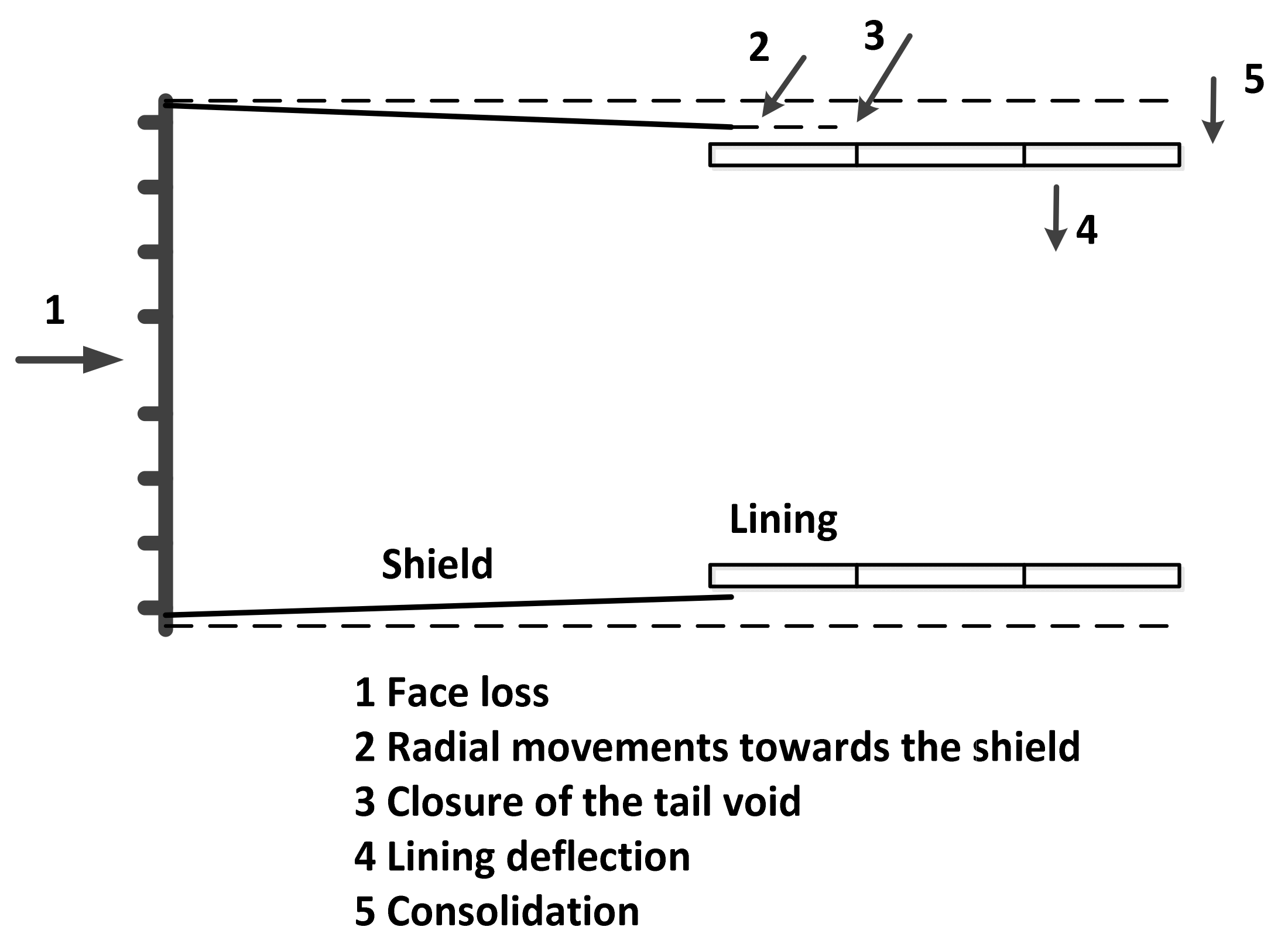
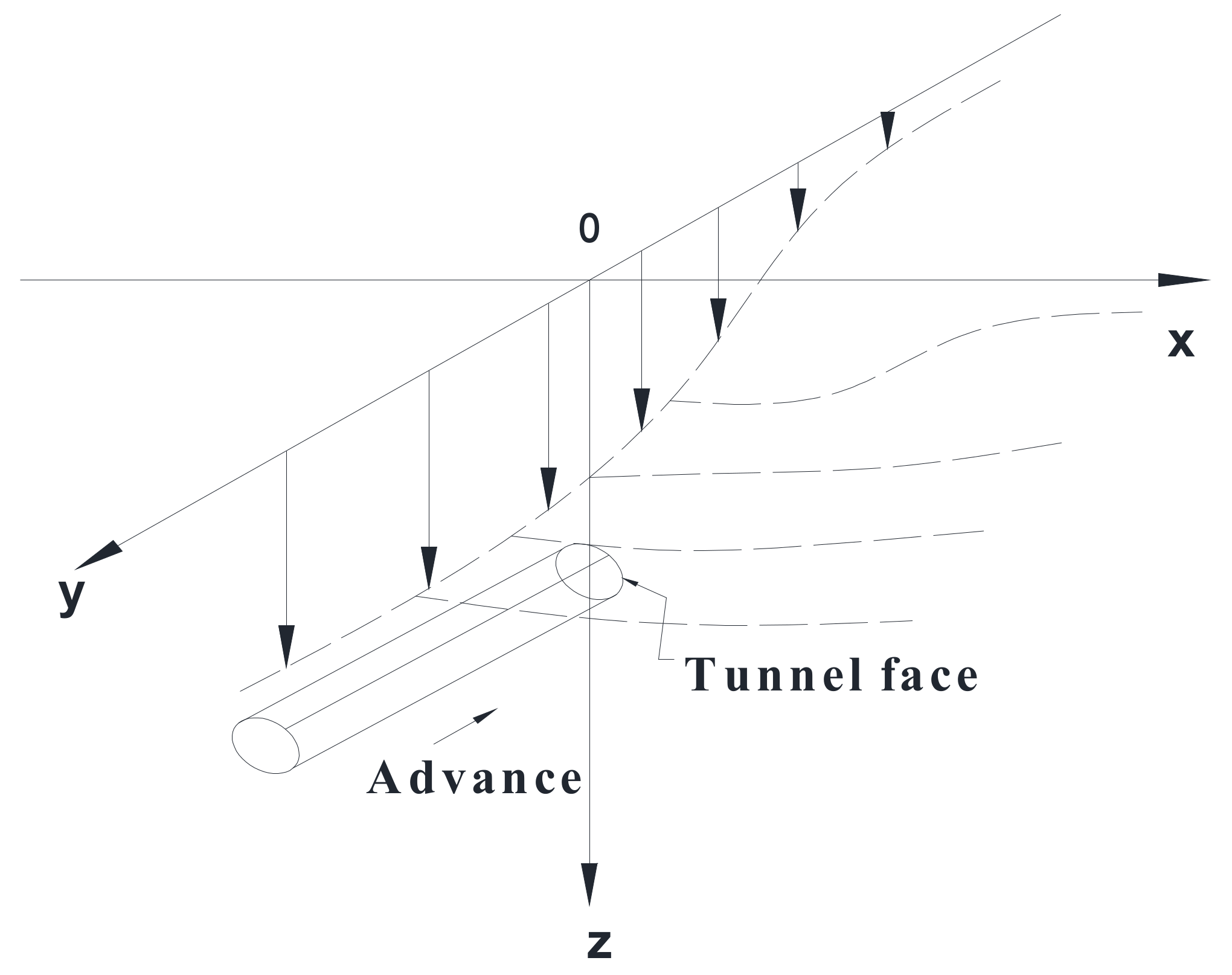
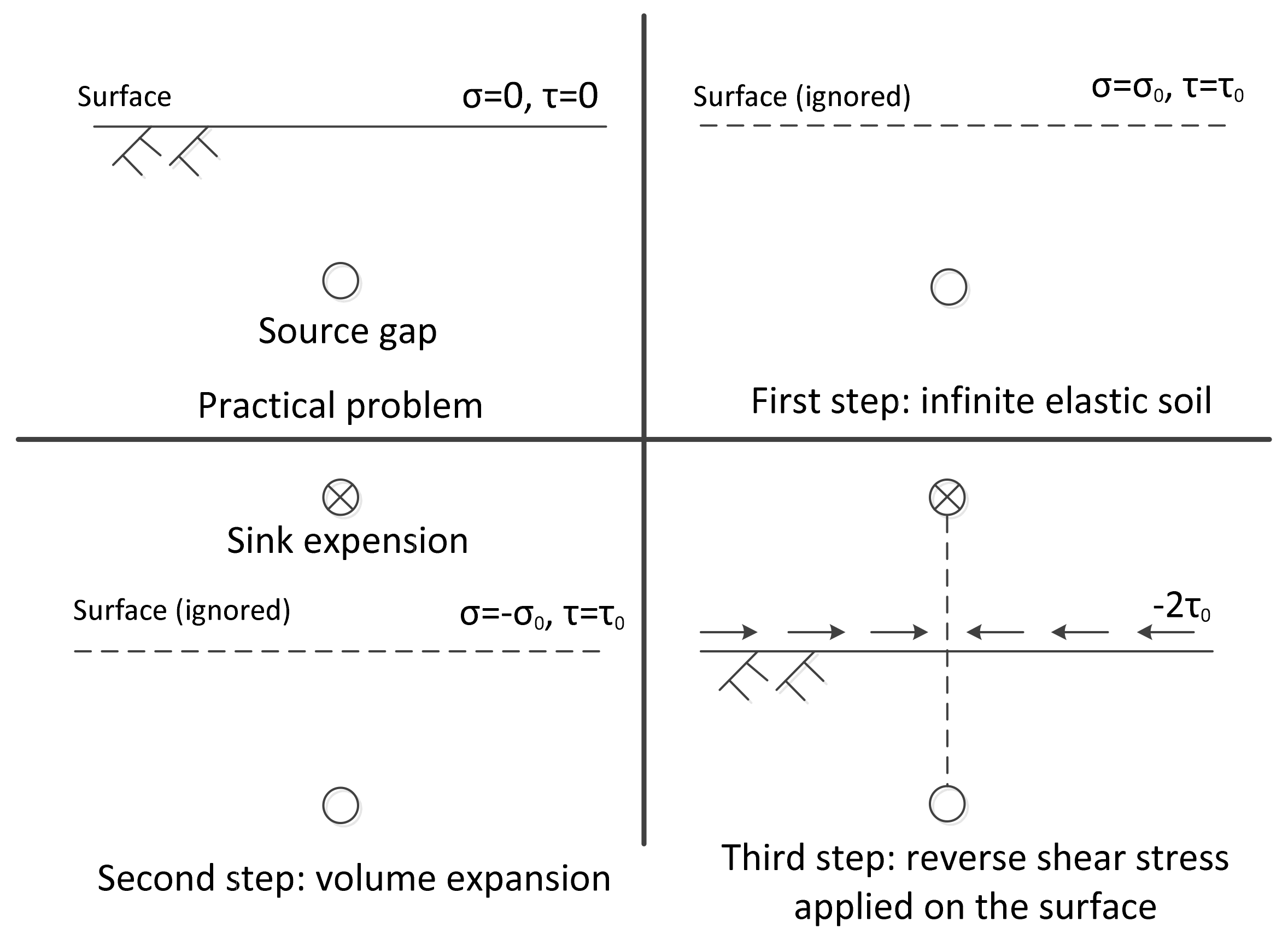

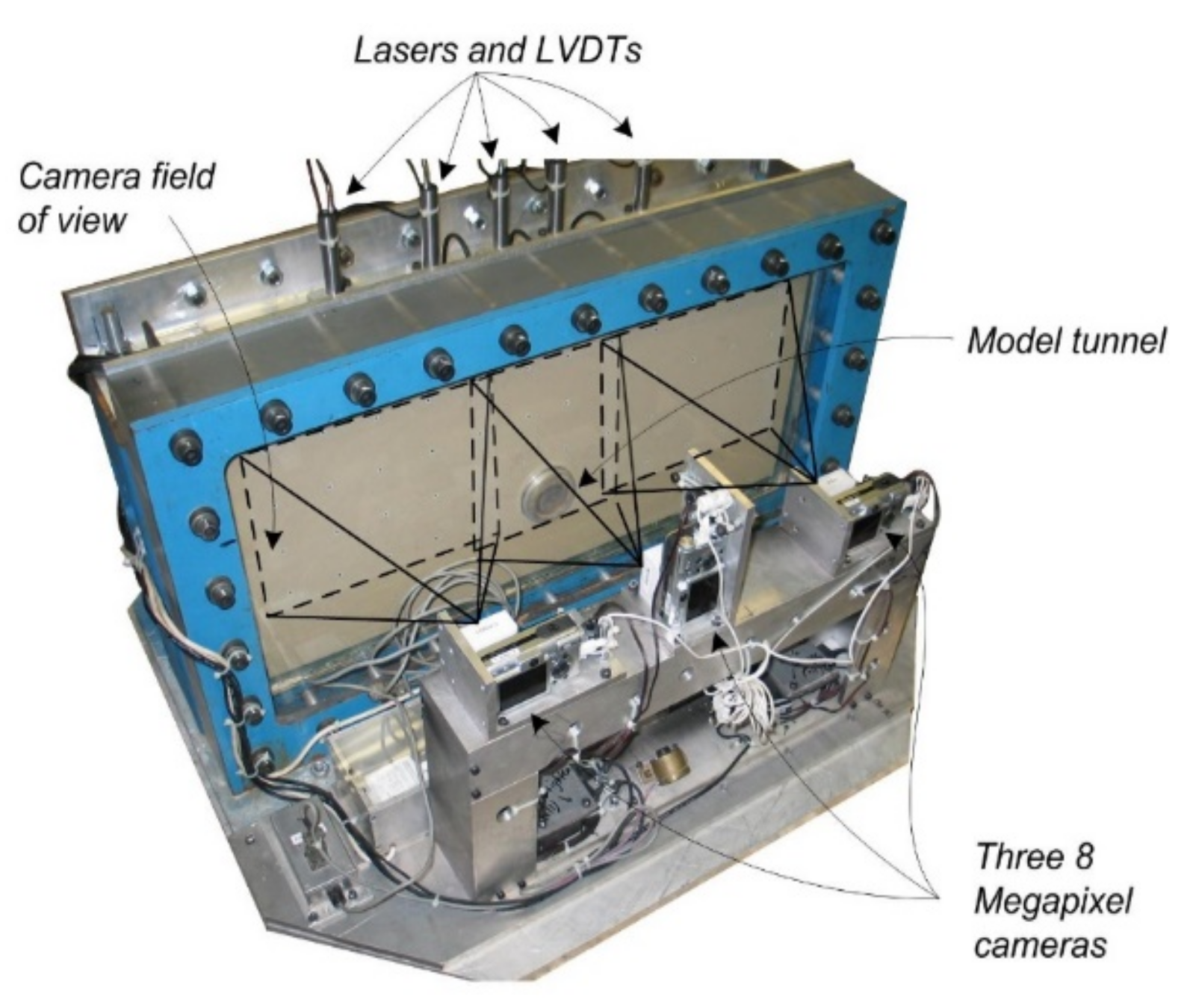
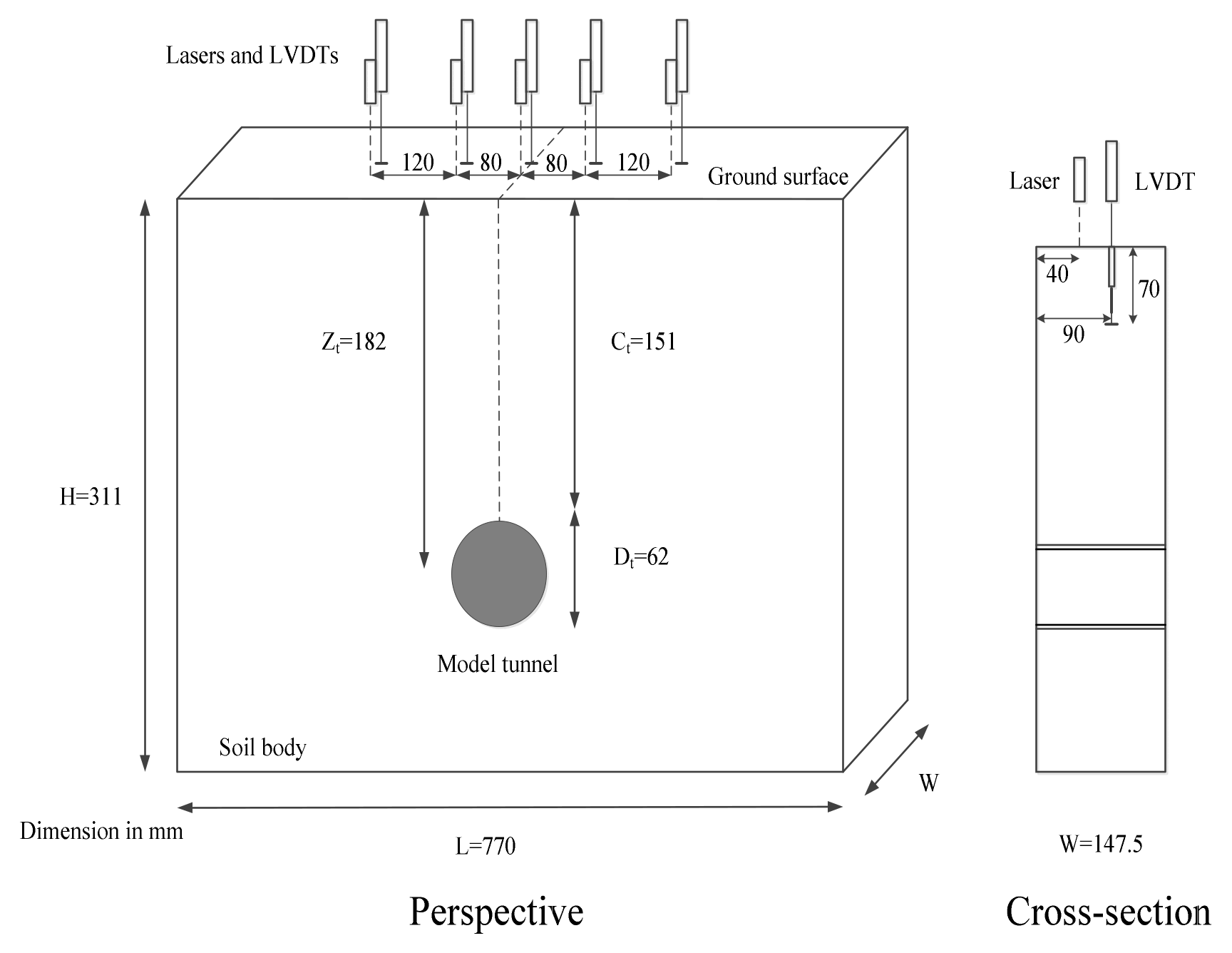
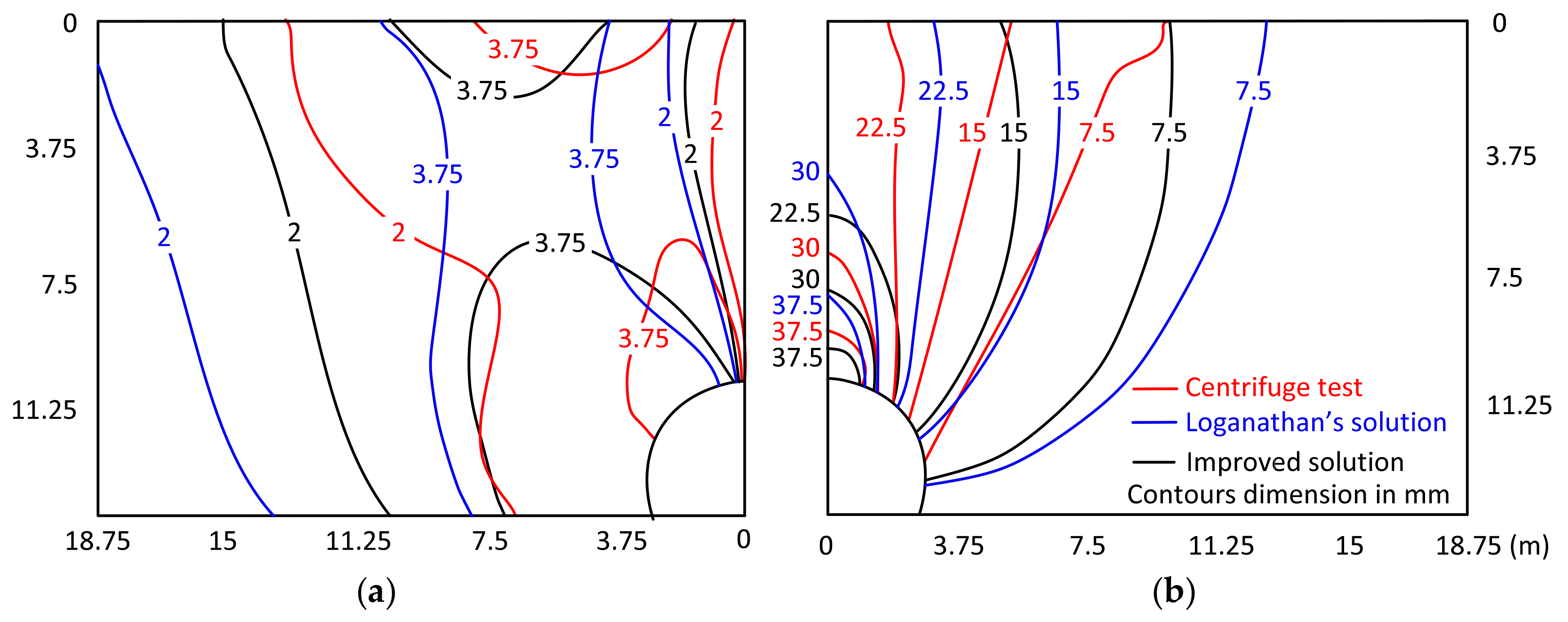
| Material | Unit Weight (kN/m3) | Typical D50 (µm) | Maximum/Minimum Void Ratios | Relative Density | Poisson’s Ratio | Elastic Modules (MPa) |
|---|---|---|---|---|---|---|
| Dry Leighton Buzzard Fraction E silica sand, UK. | 26.7 | 122 | 0.97/0.64 | 90% | 0.4 | 20 |
© 2019 by the authors. Licensee MDPI, Basel, Switzerland. This article is an open access article distributed under the terms and conditions of the Creative Commons Attribution (CC BY) license (http://creativecommons.org/licenses/by/4.0/).
Share and Cite
Tan, X.; Zhang, H.; Zhang, G.; Zhu, Y.; Tu, P. An Improved Method for Predicting the Greenfield Stratum Movements Caused by Shield Tunnel Construction. Appl. Sci. 2019, 9, 4522. https://doi.org/10.3390/app9214522
Tan X, Zhang H, Zhang G, Zhu Y, Tu P. An Improved Method for Predicting the Greenfield Stratum Movements Caused by Shield Tunnel Construction. Applied Sciences. 2019; 9(21):4522. https://doi.org/10.3390/app9214522
Chicago/Turabian StyleTan, XinRong, Heng Zhang, Gang Zhang, Yimo Zhu, and Peng Tu. 2019. "An Improved Method for Predicting the Greenfield Stratum Movements Caused by Shield Tunnel Construction" Applied Sciences 9, no. 21: 4522. https://doi.org/10.3390/app9214522
APA StyleTan, X., Zhang, H., Zhang, G., Zhu, Y., & Tu, P. (2019). An Improved Method for Predicting the Greenfield Stratum Movements Caused by Shield Tunnel Construction. Applied Sciences, 9(21), 4522. https://doi.org/10.3390/app9214522





